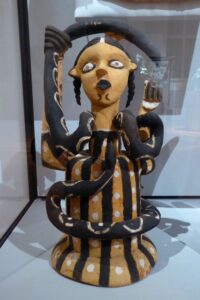It is believed that all of ancient Africa possessed a multitude of water-spirit traditions before the first contact with Europeans.[2]

Mami Wata (also Mamba Muntu, Water Mother, La Sirene) also goes by the names Mama Glo, Mama de Agua and Watramama, is a water spirit venerated in West, Central, and Southern Africa and in the Afro-American diaspora.


This image—an enticing woman with long, black hair and a large snake slithering up between her breasts, ambiguous if she is human or mermaid beyond the image—apparently caught the imaginations of the Africans who saw it; it was the definitive image of the spirit.[19] Before long, Mami Wata posters appeared in over a dozen countries and the popular image was reproduced in 1955 by the Shree Ram Calendar Company in Bombay for the African market.[1] People began creating Mami Wata art of their own, much of it influenced by the lithograph.
